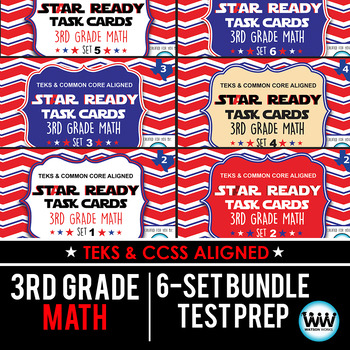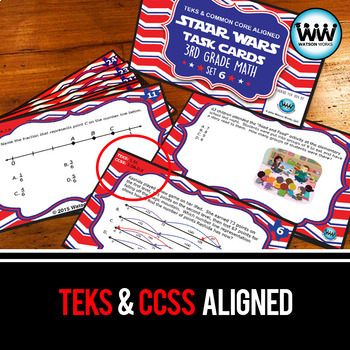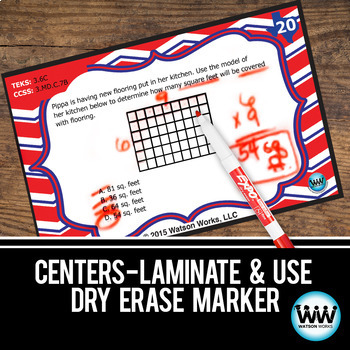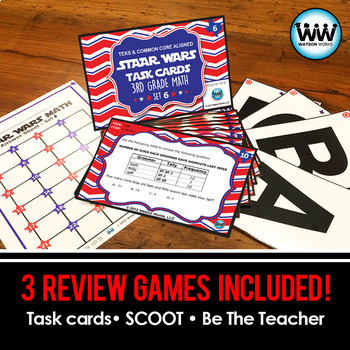SETS 1-6 BUNDLE - STAR READY 3rd Grade Math Task Cards - STAAR / TEKS-aligned
- Zip
What educators are saying
Products in this Bundle (6)
showing 1-5 of 6 products
Description
#testprepsale
*SAVE 20% WHEN YOU PURCHASE THIS BUNDLE!*
**3rd GRADE STAAR MATH TASK CARDS FOR THE ENTIRE SCHOOL YEAR!**
***ALIGNED WITH MOST UPDATED MATH TEKS!***
****WE’VE ADDED SET NUMBERS TO EACH TASK CARD TO DISTINGUISH BETWEEN SETS.****
***************************************************************************
Don’t wait until right before the end-of-year STAAR or other state assessment to get your students ready for the test! Prepare them each 6 weeks of school with our STAAR Wars 3rd Grade Math Task Cards! This BUNDLE includes sets 1-6 for the 1st, 2nd, 3rd, 4th, 5th, and 6th 6 weeks of school.
Each set includes 24 task cards aligned with 3rd grade math TEKS and common core standards and are perfect for assessing where your students are and where you need to go for the next 6 weeks of school.
These rigorous, higher-level thinking questions are made in STAAR format, have multiple choice answers, and address these skills:
Set 1:
•1-step & 2-step problems – solve & represent problems involving addition/subtraction within 1,000
•Analyze & communicate mathematical ideas & relationships
•Communicate mathematical ideas using graphs, number lines
•Compare & order whole numbers up to 100,000
•Compose & decompose numbers up to 100,000
•Estimation
•Money – determining value of a collection of bills & coins
•Number lines between 2 consecutive multiples of 10, 100, 1,000, & 10,000
•Perimeter of a polygon or missing length
•Place value through hundred thousands place
•Rounding to the nearest 10 or 100
Standards Covered:
•TEKS - 3.1D, 3.1F, 3.1G, 3.2, 3.2A, 3.2B, 3.2C, 3.2D, 3.4A, 3.4B, 3.4C, 3.5A, 3.7B
•CCSS - 2.NBT.A.1, 2.NBT.A.2, 2.NBT.A.4, 2.MD.B.6, 2.MD.C.8, 3.MD.D.8, 3.NBT.A.2, 3.NBT.A.3, 3.OA.D.8
Set 2:
•Analyze & communicate mathematical ideas & relationships
•Area of rectangles with whole number side lengths using multiplication (number of rows x number of unit squares in each row)
•Explain mathematical ideas using mathematical language
•Describe multiplication expression as a comparison
•Determine number of objects arranged in equally-sized groups of objects or arrays
•Determine number of objects in groups when shared equally or separated into equal shares
•Determine quotient using relationship between multiplication & division
•Determine unknown whole number in multiplication with a missing factor or product
•Frequency tables
•Multiply 2-digit number by 1-digit number
•Recall multiplication facts up to 10x10
•Represent multiplication facts with arrays, equal-sized groups, area models, skip counting
•Represent/solve 1-step & 2-step problems – solve & represent problems involving multiplication/division within 100 using arrays, strip diagrams, & equations
Standards Covered:
•TEKS - 3.1G, 3.4D, 3.4E, 3.4F, 3.4G, 3.4H, 3.4J, 3.4K, 3.5B, 3.5C, 3.5D, 3.6C, 3.8A
•CCSS - 3.MD.B.3, 3.MD.C.7A, 3.MD.C.7B, 3.OA.A.1, 3.OA.A.2, 3.OA.A.3, 3.OA.B.5, 3.OA.C.7, 3.OA.D.8, 4.NBT.B.5
Set 3:
• Compose and decompose a fraction a/b with a numerator greater than zero and less than or equal to b as a sum of parts 1/b
• Describe the relationship between the availability or scarcity of resources and how that impacts cost
• Determine a quotient using the relationship between multiplication and division
• Determine if a number is even or odd using divisibility rules
• Determine the corresponding fraction greater than zero and less than or equal to one with denominators of 2, 3, 4, 6, and 8 given a specified point on a number line
• Explain that credit is used when wants or needs exceed the ability to pay and that it is the borrower’s responsibility to pay it back to the lender, usually with interest
• Explain that the unit fraction 1/b represents the quantity formed by one pa
• Explain that two fractions are equivalent if and only if they are both represented by the same point on the number line or represent the same portion of a same size whole for an area mode
• Explain the connection between human capital/labor and income
• List reasons to save and explain the benefit of a savings plan, including for college
• Represent fractions greater than zero & less than or equal to one with denominators of 2, 3, 4, 6, and 8 using: pictorial models
• Represent fractions of halves, fourths, and eighths as distances from zero on a number line
• Solve problems involving partitioning an object or a set of objects among two or more recipients using pictorial representations of fractions with denominators of 2, 3, 4, 6, and 8
•Use strategies and algorithms, including the standard algorithm, to multiply a two‐digit number by a one‐digit number.
Standards Covered:
•TEKS - 3.3A, 3.3B, 3.3C, 3.3D, 3.3E, 3.3G, 3.4G, 3.4I, 3.4J, 3.7A, 3.9A, 3.9B, 3.9C, 3.9D, 3.9E, 3.9F
•CCSS - 2.OA.C.3, 3.NF.A.1, 3.NF.A.2, 3.NF.A.2a, 3.NF.A.2b, 3.OA.B.5, 3.OA.B.6, 4.NF.B.3b, CEE 4.1.1, CEE 4.1.7, CEE 4.2.2, CEE 4.2.5, CEE 4.2.6, CEE 4.2.7, CEE 4.3.2, CEE 4.3.4, CEE 4.4.4
Set 4:
•Decompose composite figures formed by rectangles into non-overlapping rectangles to determine the area of the original figure using the additive property of area
• Determine the unknown number in a multiplication or division equation relating 3 whole numbers when the unknown number is either a missing factor or product
• One-step & two-step problems involving addition & subtraction within 1,000
• One-step & two-step problems involving multiplication & division within 100
• Represent real-world relationships using number pairs in a table & verbal descriptions
• Solve one-step & two-step problems using categorical data represented with a frequency table, dot plot, pictograph, or bar graph with scaled intervals
• Summarize a data set with multiple categories, using a frequency table, dot plot, pictograph, or bar graph with scaled intervals
• Use arrays, strip diagrams, & equations to represent one-step & two-step problems involving multiplication & division problems within 100
• Use pictorial models, number lines, & equations to represent one-step & two-step problems involving addition & subtraction of whole numbers to 1,000
• Use strategies & algorithms to multiply a 2-digit number by a 1-digit number
Standards Covered:
•TEKS - 3.4A, 3.4G, 3.4K, 3.5A, 3.5B, 3.5D, 3.5E, 3.6D, 3.8A, 3.8B
•CCSS - 3.MD.B, 3.MD.C.7d, 3.OA.A.3, 3.OA.B.5, 3.OA.C.7, 3.OA.D.8, 3.OA.D.9
Set 5:
•Compare two fractions having the same numerator or denominator in problems by reasoning about their sizes and justifying the conclusion using symbols, words, objects, and pictorial models.
• Decompose composite figures formed by rectangles into non-overlapping rectangles to determine the area of the original figure using the additive property of area.
• Determine liquid volume (capacity) or weight using appropriate units and tools.
• Determine the area of rectangles with whole number side lengths in problems using multiplication related to the number of rows times the number of unit squares in each row.
• Determine the perimeter of a polygon or a missing length when given perimeter and remaining side lengths in problems.
• Determine the solutions to problems involving addition and subtraction of time intervals in minutes using pictorial models or tools such as a 15-minute event plus a 30-minute event equals 45 minutes.
•Determine when it is appropriate to use measurements of liquid volume (capacity) or weight.
• Explain that two fractions are equivalent if and only if they are both represented by the same point on the number line or represent the same portion of a same size whole for an area model.
• Represent equivalent fractions with denominators of 2,3, 4, 6, and 8 using a variety of objects and pictorial models, including number lines.
Standards Covered:
•TEKS - 3.3F, 3.3G, 3.3H, 3.6C, 3.6D, 3.7B, 3.7C, 3.7D, 3.7E
•CCSS - 3.MD.A.1, 3.MD.A.2, 3.MD.C.7, 3.MD.C.7.A, 3.MD.C.7.B, 3.MD.C.7.D, 3.MD.D.8, 3.NF.A.1, 3.NF.A.3.A, 3.NF.A.3.B, 3.NF.A.3.C, 3.NF.A.3.D
Set 6:
•Compare two fractions having the same numerator or denominator in problems by reasoning about their sizes and justifying the conclusion using symbols, words, objects, and pictorial models.
• Determine the area of rectangles with whole number side lengths in problems using multiplication related to the number of rows times the number of unit squares in each row.
• Determine the corresponding fraction greater than zero and less than or equal to one with denominators of 2, 3, 4, 6, and 8 given a specified point on a number line.
• Determine the perimeter of a polygon or a missing length when given perimeter and remaining side lengths in problems.
• Explain that two fractions are equivalent if and only if they are both represented by the same point on the number line or represent the same portion of a same size whole for an area model.
• Represent and solve one- and two-step multiplication and division problems within 100 using arrays, strip diagrams, and equations.
• Represent one- and two-step problems involving addition and subtraction of whole numbers to 1,000 using pictorial models, number lines, and equations.
• Solve one- and two-step problems using categorical data represented with a frequency table, dot plot, pictograph, or bar graph with scaled intervals.
• Solve one- and two-step problems involving multiplication and division within 100 using strategies based on objects; pictorial models, including arrays, area models, and equal groups; properties of operations; or recall facts.
• Solve problems involving partitioning an object or a set of objects among two or more recipients using pictorial representations of fractions with denominators of 2, 3, 4, 6, and 8.
• Solve with fluency one-step and two-step problems involving addition and subtraction within 1,000 using strategies based on place value, properties of operations, and the relationship between addition and subtraction.
Standards Covered:
•TEKS - 3.3B, 3.3E, 3.3G, 3.3H, 3.4A, 3.4K, 3.5A, 3.5B, 3.6C, 3.7B, 3.8B
•CCSS - 3.MD.B.3, 3.MD.C.7.B, 3.MD.C.7.D, 3.MD.D.8, 3.NF.A.1, 3.NF.A.2.B, 3.NF.A.3.A, 3.NF.A.3.C, 3.NF.A.3.C, 3.NF.A.3.D, 3.OA.A.3, 3.OA.D.8, 4.MD.B.4
Instructions are included for 3 methods of review: task cards review in centers/groups/pairs/individuals, a SCOOT game, and a "Be the Teacher" game.
We hope you enjoy them, and we’d love to hear your feedback! :)
Follow us on TpT, Facebook, Instagram and/or Pinterest to be alerted when other products and sales are available.
~Heather & Ashley
Watson Works, LLC
*Full preview of the product available by selecting the preview button above.
**You may also like our 3rd Grade Reading Bundle, as well!
Terms of Use:
© 2015 Watson Works, LLC. Except as permitted under the United States Copyright Act, no part of this publication may be reproduced, stored, or distributed in any form or by any means (mechanically, electronically, recording, etc.) without the prior written consent of Watson Works, LLC. Purchasing this product in digital form from the Watson Works store on TeachersPayTeachers.com licenses one teacher to use this product in his/her classroom or for personal use. Additional licenses must be purchased for additional teachers to use this product. Made in the USA. All rights reserved.





